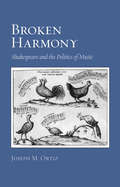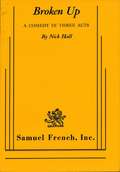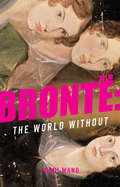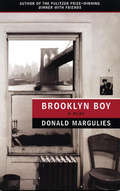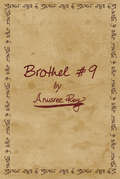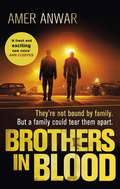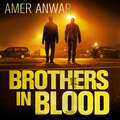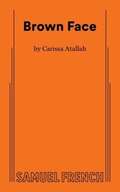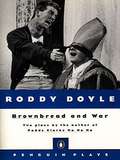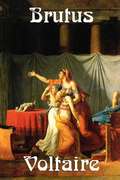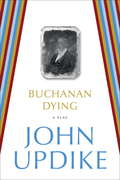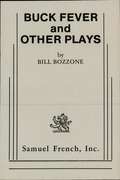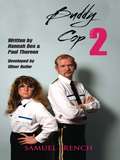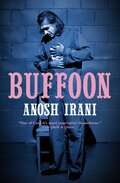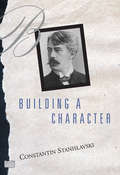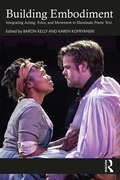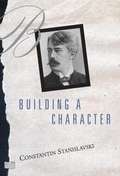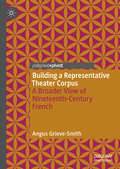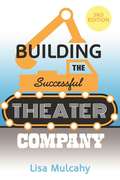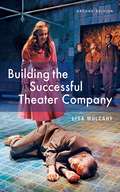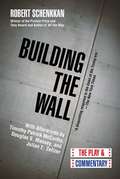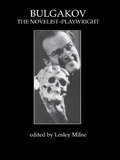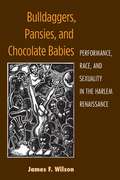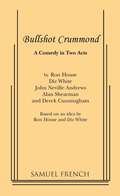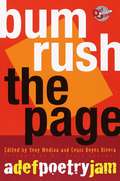- Table View
- List View
Broken Harmony: Shakespeare and the Politics of Music
by Joseph M. OrtizMusic was a subject of considerable debate during the Renaissance. The notion that music could be interpreted in a meaningful way clashed regularly with evidence that music was in fact profoundly promiscuous in its application and effects. Subsequently, much writing in the period reflects a desire to ward off music’s illegibility rather than come to terms with its actual effects. In Broken Harmony Joseph M. Ortiz revises our understanding of music’s relationship to language in Renaissance England. In the process he shows the degree to which discussions of music were ideologically and politically charged. Offering a historically nuanced account of the early modern debate over music, along with close readings of several of Shakespeare’s plays (including Titus Andronicus, The Merchant of Venice, The Tempest, and The Winter’s Tale) and Milton’s A Maske, Ortiz challenges the consensus that music’s affinity with poetry was widely accepted, or even desired, by Renaissance poets. Shakespeare more than any other early modern poet exposed the fault lines in the debate about music’s function in art, repeatedly staging disruptive scenes of music that expose an underlying struggle between textual and sensuous authorities. Such musical interventions in textual experiences highlight the significance of sound as an aesthetic and sensory experience independent of any narrative function.
Broken Up
by Nick HallComedy / 3m, 1f / Interior Meg Owens is in the middle of moving into her new apartment and out of her old marriage. All she has to do is have Tom, her husband, sign the final papers and then she can start her new life. However, signing the final papers becomes increasingly difficult, and her new life, represented by an amorous landlord and a fast talking divorce expert, is already under way.
Brontë: The World Without
by Jordi MandWhat happens when a passion is turned into a means to survive? Sisters Charlotte, Emily, and Anne Brontë have always enjoyed writing and storytelling, but so far, it’s been for their own personal enjoyment. Now that their father is sick and their brother is an alcoholic, they have to be the ones to support the family. They’d rather focus on their careers than settling down with suitors anyway, so writing is what could save them. But is it also what could tear them apart? Jealousy, rivalry, and the strong need for self-expression threaten not only their livelihoods and relationships but also their confidence in creativity and what could be their legacy. Told over five days in the span of three years, the fascinating story of the Brontë sisters’ pioneering literary careers unfolds to show what it was like to be an ambitious woman in the 1800s, and how similar it looks to the struggles women still face today.
Brooklyn Boy
by Donald Margulies"A terrific production . . . American playwright Donald Margulies' self-reflective, dream reverie comedy drama Brooklyn Boy is tough, insightful, bittersweet, funny and ultimately wise."--The Hollywood Reporter"Those who know Margulies' plays will find his familiar themes here: the inevitable transformations wrought by aging, the complex hands linking parents and children, the uneasy dance between commercial and artistic success. The story unfolds with an uncanny resonance that distinguishes all great theatre."--Orange County RegisterThis new play by the Pulitzer Prize-winning author of Dinner with Friends is slated for a Broadway run in January 2005. Brooklyn Boy follows the career of Eric Weiss, a writer whose novel hits the bestseller list the same time his life begins to unravel. His wife is out the door, his father is in the hospital and his childhood friend thinks he has sold himself to the devil. A funny and emotionally rich look at family, friends and fame.Donald Margulies received the 2000 Pulitzer Prize for Drama for Dinner with Friends. The play received numerous awards, including the American Theatre Critics Association New Play Award, the Dramatists Guild/Hull-Warriner Award, the Lucille Lortel Award, the Outer Critics Circle Award and a Drama Desk nomination, and has been produced all over the United States and around the world. In addition to his adaptation of God of Vengeance, his many plays include Collected Stories, Sight Unseen, The Model Apartment, The Loman Family Picnic, What's Wrong with This Picture? and Two Days. Mr. Margulies currently lives with his wife and their son in New Haven, Connecticut, where he teaches playwriting at Yale University.
Brothel #9
by Anusree Roy Iris TurcottA deal has been struck between two men in India—twenty-one hundred rupees in exchange for a young village woman named Rekha. Sent to Calcutta without knowing why, Rekha finds herself in the confines of a brothel with Jamuna, a prostitute and madam, who is resigned to her trade. In these conditions, Rekha must shape her destiny and find inner liberty.
Brothers in Blood (Zaq & Jags)
by Amer AnwarTHE TIMES BOOKS OF THE YEAR 2018 GUARDIAN BEST BOOKS OF THE YEAR 2018BOOKS IN THE MEDIA BEST CRIME BOOKS OF 2018FEATURED ON CRIME TIME BEST OF THE YEAR 2018 WINNER OF THE CWA DEBUT DAGGER'[A] brilliant debut' Sunday Times Crime Club'A fresh and exciting new voice to the genre' Ann Cleeves'Gritty, compelling and authentic' Daily Express'Fascinating' CJ Carver'Enjoyable. Fast-paced. Recommended.' Observer'Raw! Authentic! The crime thriller that I've been waiting for' Khurram Rahman'Terrific' The Times'One of the best books I've read this year' The Crime Novel Reader'Impressive, Brutal, Convincing' Mail on Sunday 'You won't be putting this book down' Hardeep Singh Kohli'A satisfying slice of action-led crime . . . readers (will be) hooked from the off' Skinny***THEY'RE NOT BOUND BY FAMILY. BUT A FAMILY COULD TEAR THEM APART.Southall, West London. After being released from prison, Zaq Khan is lucky to land a dead-end job at a builders' yard. All he wants to do is keep his head down and put the past behind him. But when Zaq is forced to search for his boss's runaway daughter, he quickly finds himself caught up in a deadly web of deception, murder and revenge. With time running out and pressure mounting, can he find the missing girl before it's too late? And if he does, can he keep her - and himself - alive long enough to deal with the people who want them both dead?
Brothers in Blood (Zaq & Jags)
by Amer AnwarTHE TIMES BOOKS OF THE YEAR 2018 GUARDIAN BEST BOOKS OF THE YEAR 2018BOOKS IN THE MEDIA BEST CRIME BOOKS OF 2018FEATURED ON CRIME TIME BEST OF THE YEAR 2018 WINNER OF THE CWA DEBUT DAGGER'[A] brilliant debut' Sunday Times Crime Club'A fresh and exciting new voice to the genre' Ann Cleeves'Gritty, compelling and authentic' Daily Express'Fascinating' CJ Carver'Enjoyable. Fast-paced. Recommended.' Observer'Raw! Authentic! The crime thriller that I've been waiting for' Khurram Rahman'Terrific' The Times'One of the best books I've read this year' The Crime Novel Reader'Impressive, Brutal, Convincing' Mail on Sunday 'You won't be putting this book down' Hardeep Singh Kohli'A satisfying slice of action-led crime . . . readers (will be) hooked from the off' Skinny***THEY'RE NOT BOUND BY FAMILY. BUT A FAMILY COULD TEAR THEM APART.Southall, West London. After being released from prison, Zaq Khan is lucky to land a dead-end job at a builders' yard. All he wants to do is keep his head down and put the past behind him. But when Zaq is forced to search for his boss's runaway daughter, he quickly finds himself caught up in a deadly web of deception, murder and revenge. With time running out and pressure mounting, can he find the missing girl before it's too late? And if he does, can he keep her - and himself - alive long enough to deal with the people who want them both dead?
Brown Face
by Carissa AtallahGracia is a Chicana writer and DREAMer. In order to draw attention to her work but not her undocumented status, Gracia convinces her white and US-born best friend Mariza to perform her poetry. When Gracia's words launch Mariza into gaining a following as a Latinx artist and activist, their friendship is tested by issues of privilege and cultural appropriation. Part play, part poetry slam, Brown Face follows a group of college students as they navigate their identities in the competitive world of spoken word poetry.
Brownbread and War
by Roddy DoyleFrom novelist and screenwriter Roddy Doyle come these two colorful plays. both set in the North Dublin suburb of Barrytown. In Brownbread, three young men kidnap a bishop but soon come to realize--when the U. S. Marines invade--that their brilliant adventure is nothing more than a colossal mistake. War is set at the Hiker's Rest, a pub where two trivia addicts meet every month to answer questions posed by Denis trhe quizmaster who hates wrong answers and shoots to kill. These earthy, exuberant works show why The New York Times Book Review says Doyle's "versatility and brio. . . may shock the neighbors, but. . . you can't take your eyes off him. " .
Brutus
by VoltaireThis tragedy was produced in 1730. It marks Voltaire's spirit of daring in treating a subject from which Shakespeare shrank as, perhaps, too painful for representation. When revived during the Revolution it was enthusiastically applauded. Wilder Publications is a green publisher. All of our books are printed to order. This reduces waste and helps us keep prices low while greatly reducing our impact on the environment.
Buchanan Dying
by John UpdikeTo the list of John Updike's well-intentioned protagonists--Rabbit Angstrom, George Caldwell, Piet Hanema, Henry Bech--add James Buchanan, seen above as a young Congressman in the 1820's, and on the front cover as the harried fifteenth President of the United States (1857-1861). In a play meant to be read, Buchanan's political and private lives are represented as aspects of his spiritual life, whose crowning, condensing act is the act of dying. A wide-ranging Afterword rounds out the dramatic portrait of one of America's lesser known, and least appreciated, leaders.
Buck Fever & Other Plays
by Bill BozzoneComedy / 3m, 1f / Interior / A remarkable and hilarious play about two hunting buddies who, upon returning to their cabin in the woods, discover that their wives have become lovers in the husbands' absence and then absconded with the only car, leaving the miserable (and very confused) husbands stranded alone. Fully expecting the return of their wayward wives, the husbands decide to jump into bed together, so that upon their return, the wives, will see just how ridiculous homosexuality looks. What the husbands don't expect is their discovery in bed by another hunting buddy and his date.
Buddy Cop 2
by Hannah BosDark Comedy Characters: 2 male, 2 female. Interior. Two cops...in the kind of quiet little town where a kid dreams of growing up to be a fireman. Or a racecar driver. Where the only question you ask yourself at the end of the day is if you're gonna knock back your cold one at Swanky's, Spanky's, or Zingers. A town where neighbors pitch in to help neighbors in need, and where if you wake up in the middle of the night...you should keep your eyes closed. Because the man in red is there in the corner. Watching you. Smiling at you with his yellow eyes and black teeth. Best to pretend you're still asleep. In this comedic action/mystery of holiday nostalgia and athletic rigor, when a flood destroys the police station, the local cops set up shop in the nearby community center. Mysteries emerge. Criminals are chased. Racquetball is played. In this town, nothing is what it seems...or is it? . "Set in the 1980s, this downtown gem, full of minor-key revelations and offhand epiphanies, roots its quirky charm in an earnest and surprising realism. This charming, offbeat play from the Debate Society of Brooklyn is sneakily funny, but not at the expense of its characters, mumbling sweeties who play bingo, collect beer cans, and take pride in their work." -The New York Times . "Packed with nonchalant theatrics and smoldering intensity. Bos, Thureen, and Butler have woven an accomplished yarn." -Back Stage.. "Wistful and sweet and uncanny. The delightful, oddly delicate Buddy Cop 2 is steeped in Christmas cheer. FOUR STARS. Critics' Pick." -Time Out New York. "Wonderfully entertaining. Funny, Charming, and perfectly pitched." - NYTheatre. com.
Buffoon
by Anosh IraniThree-time Governor General’s Literary Award–shortlisted author and playwright Anosh Irani’s critically acclaimed one-man show Buffoon is a masterclass of tragicomic theatre. Born to circus folk who prefer trapezing over parenting, Felix quickly learns to turn life’s misfortunes into jokes. His longing for family and home is piqued at the tender age of seven when he falls hopelessly in love with an older woman, the beguiling Aja, who is eight. In the process, a clown is born, and we watch him grow into a middle-aged buffoon. Over time, Felix stops waiting for someone else to love him; his journey becomes one of loving himself. A story of love, loss, and the fate that binds us, Buffoon is a gut-wrenching one-man show that expertly walks the tightrope between heartbreak and hilarity.
Building A Character (Bloomsbury Revelations Ser.)
by Constantin StanislavskiBuilding a Character is one of the three volumes that make up Stanislavski’s The Acting Trilogy. An Actor Prepares explores the inner preparation an actor must undergo in order to explore a role to the full. In this volume, Sir John Gielgud said, this great director “found time to explain a thousand things that have always troubled actors and fascinated students.” Building a Character discusses the external techniques of acting: the use of the body, movement, diction, singing, expression, and control. Creating a Role describes the preparation that precedes actual performance, with extensive discussions of Gogol’s The Inspector General and Shakespeare’s Othello. Sir Paul Scofield called Creating a Role “immeasurably important” for the actor. These three volumes belong on any actor’s short shelf of essential books.
Building Embodiment: Integrating Acting, Voice, and Movement to Illuminate Poetic Text
by Baron Kelly Karen KopryanskiBuilding Embodiment: Integrating Acting, Voice, and Movement to Illuminate Poetic Text offers a collection of strategic and practical approaches to understanding, analyzing, and embodying a range of heightened text styles, including Greek tragedy, Shakespeare, and Restoration/comedy of manners. These essays offer insights from celebrated teachers across the disciplines of acting, voice, and movement and are designed to help actors and instructors find deeper vocal and physical connections to poetic text. Although each dramatic genre offers a unique set of challenges, Building Embodiment highlights instances where techniques can be integrated, revealing how the synthesis of body, brain, and word results in a fuller sense of character experiencing for both the actor and the audience. This book bridges the gap between academic and professional application and invites the student and professional actor into a richer experience of character and story.
Building a Character
by Elizabeth Reynolds Hapgood Constantin Stanislavski<p>This vintage book contains Constantin Stanislavski's famous 1950 treatise, "Building a Character." Written by the father of method acting, this definitive handbook on the naturalistic approach to acting has been studied by some of best, and continues to be an invaluable and timeless tool for actors all over the world. <p>A must-have for aspiring and seasoned actors alike, "Building a Character" would make for a worthy addition to any collection. Konstantin Sergeievich Stanislavski (1863 - 1938) was a Russian actor and theatre director, famous for being the progenitor of the Stanislavski method. Stanislavski received the 'Order of Lenin' in 1937, the 'Order of the Red Banner of Labour' in 1938, and 'People's Artist of the USSR' in 1936 for his prolific contributions to the arts. <p>Elected for republication due to its immense historical and educational value, this book is being republished now in an affordable, modern, high-quality edition. It comes complete with a specially commissioned new biography of the author.</p>
Building a Representative Theater Corpus: A Broader View of Nineteenth-Century French
by Angus Grieve-SmithThe Digital Parisian Stage Project aims to compile a corpus of plays that are representative of performances in the theaters of Paris through history. This book surveys existing corpora that cover the nineteenth century, lays out the issue of corpus representativeness in detail, and, using a random sample of plays from this period, presents two case studies of language in use in the Napoleonic era. It presents a compelling argument for the compilation and use of representative corpora in linguistic study, and will be of interest to those working in the fields of corpus linguistics, digital humanities, and history of the theater.
Building the Successful Theater Company
by Lisa MulcahyWhat makes a theater company successful? Lisa Mulcahy poses the question to leaders from nineteen of the country’s most diverse and vital theater companies from the recent past and present, and offers answers in Building the Successful Theater Company. Producers, stage managers, directors-anyone dreaming of running a theater troupe-will benefit from the practical guidance, amusing anecdotes, and sincere advice in this peek behind the curtains of the often difficult, always seductive, profession of theater. With five additional companies profiled in this fully revised third edition, Building a Successful Theater Company features: The LABrynth Theater Company New Paradise Laboratories National Theatre of the Deaf Shotgun Players Asian-American Theatre Company Steppenwolf Theater Company The Pasadena Playhouse La Jolla Playhouse Chicago City Limits Berkeley Repertory Theatre Arena Stage’s The Living Stage Theatre Company Mixed Blood Theatre Company Horizons Theatre Wheelock Family Theatre L.A. Theatre Works A Traveling Jewish Theatre Jean Cocteau Repertory Bailiwick Repertory New Repertory TheatreNew chapters cover funding and financial aspects, maximizing a company's potential through powerful social media use, and creating successful partnerships by teaming up with corporate sponsors and establishing artistic collaborations. Stage veterans reveal advice on everything from locating performance space, to developing a business plan, to and rehearsing and publicizing productions in this invaluable guide to creating or growing a theater company.Allworth Press, an imprint of Skyhorse Publishing, publishes a broad range of books on the visual and performing arts, with emphasis on the business of art. Our titles cover subjects such as graphic design, theater, branding, fine art, photography, interior design, writing, acting, film, how to start careers, business and legal forms, business practices, and more. While we don't aspire to publish a New York Times bestseller or a national bestseller, we are deeply committed to quality books that help creative professionals succeed and thrive. We often publish in areas overlooked by other publishers and welcome the author whose expertise can help our audience of readers.
Building the Successful Theater Company
by Lisa MulcahyThe second edition of Building the Successful Theater Company takes readers even deeper into the world of theatrical production, examining in great depth the financial realities of establishing--and maintaining--a successful organization. This indispensable reference is updated to include more theater company profiles with expert advice to better reveal the pitfalls, passions, and practicalities of the theater industry. The author's been-there-done-that personal experiences along with the wisdom of esteemed theater company heads will encourage readers to aim high and overcome challenges to accomplish all of their creative and financial objectives. Everything from finding a performance space, to creating a first season, to promoting a company and production, to designing a long-term plan is discussed in detail in this engaging guide--a sometimes irreverent, always relevant look behind the curtain of the modern stage troupe. Chapters include developing business and budget plans, rehearsing, attracting attention with publicity and word-of-mouth, adapting to growth, and more. No other book contains the unique insights and sound advice found in this indispensable reference.
Building the Wall: The Play and Commentary (Oberon Modern Plays Ser.)
by Julian E. Zelizer Douglas S. Massey Robert Schenkkan Timothy Patrick McCarthyIn the tradition of Hamilton and Angels in America, a powerful, politically charged, dystopian drama that couldn’t be more timely. Written in a “white-hot fury” on the eve of the 2016 election, the stunning new play by Pulitzer Prize– and Tony Award–winning dramatist Robert Schenkkan is creating a nationwide sensation. Bypassing the usual development path for plays, it has been signed up to open in five theaters across America in a National New Play Network Rolling World Premiere, starting in Los Angeles (March) and Denver (April) and continuing in the Washington, DC, area, Tucson, and Miami, with more productions to follow, including in Santa Fe and New York City. Building the Wall lays out in a harrowing drama the consequences of Donald Trump’s anti-immigration campaign rhetoric turned into federal policy. Two years from now, that policy has resulted in the mass round-up of millions of illegal aliens, with their incarceration overflowing into private prisons and camps reminiscent of another century. The former warden for one facility is awaiting sentencing for what happened under his watch. In a riveting interview with a historian who has come seeking the truth, he gradually reveals how the unthinkable became the inevitable, and the faceless illegals under his charge became the face of tragedy. The play is accompanied by commentary from three prominent scholars: on the real purpose of the border wall, our dark nativist history of restricting immigration, and the tradition of political protest in art.
Bulgakov: The Novelist-Playwright
by Lesley MilneFirst published in 1996. Routledge is an imprint of Taylor & Francis, an informa company.
Bulldaggers, Pansies, and Chocolate Babies: Performance, Race, and Sexuality in the Harlem Renaissance
by James WilsonBulldaggers, Pansies, and Chocolate Babies shines the spotlight on historically neglected plays and performances that challenged early twentieth-century notions of the stratification of race, gender, class, and sexual orientation. On Broadway stages, in Harlem nightclubs and dance halls, and within private homes sponsoring rent parties, African American performers of the 1920s and early 1930s teased the limits of white middle-class morality. Blues-singing lesbians, popularly known as "bulldaggers," performed bawdy songs; cross-dressing men vied for the top prizes in lavish drag balls; and black and white women flaunted their sexuality in scandalous melodramas and musical revues. Race leaders, preachers, and theater critics spoke out against these performances that threatened to undermine social and political progress, but to no avail: mainstream audiences could not get enough of the riotous entertainment.<P> Many of the plays and performances explored here, central to the cultural debates of their time, had been previously overlooked by theater historians. Among the performances discussed are David Belasco's controversial production of Edward Sheldon and Charles MacArthur's Lulu Belle (1926), with its raucous, libidinous view of Harlem. The title character, as performed by a white woman in blackface, became a symbol of defiance for the gay subculture and was simultaneously held up as a symbol of supposedly immoral black women. African Americans Florence Mills and Ethel Waters, two of the most famous performers of the 1920s, countered the Lulu Belle stereotype in written statements and through parody, thereby reflecting the powerful effect this fictional character had on the popular imagination.<P> Bulldaggers, Pansies, and Chocolate Babies is based on historical archival research including readings of eyewitness accounts, newspaper reports, songs, and playscripts. Employing a cultural studies framework that incorporates queer and critical race theory, it argues against the widely held belief that the stereotypical forms of black, lesbian, and gay show business of the 1920s prohibited the emergence of distinctive new voices. Specialists in American studies, performance studies, African American studies, and gay and lesbian studies will find the book appealing, as will general readers interested in the vivid personalities and performances of the singers and actors introduced in the book.
Bullshot Crummond
by Ron HouseFarce / 3m, 2f / This parody of low budget 30s detective movies typifies British heroism. Teutonic villain Otto von Brunno and his evil mistress crash their plane in the English countryside and kidnap Professor Fenton who has discovered a formula for making synthetic diamonds. Bullshot Crummond is called to the rescue. Otto paralyzes Crummond with a fiendish ray. He rams a stick of dynamite in Crummond's mouth which will explode when the next person enters the room. Rosemary enters, but the static electricity in her fur wrap averts the detonation. They pursue in a hair raising car chase, but plunge over a cliff. They sneak into the dungeons where the professor is being tortured, but Crummond hopelessly loses the ensuing saber duel. Unperturbed, Crummond finally triumphs by shooting the rest of the cast.
Bum Rush the Page: A Def Poetry Jam
by Tony Medina Louis Reyes RiveraBum Rush the Page is a groundbreaking collection, capturing the best new work from the poets who have brought fresh energy, life, and relevance to American poetry. "Here is a democratic orchestration of voices and visions, poets of all ages, ethnicities, and geographic locations coming together to create a dialogue and to jam--not slam. This is our mouth on paper, our hearts on our sleeves, our refusal to shut up and swallow our silence. These poems are tough, honest, astute, perceptive, lyrical, blunt, sad, funny, heartbreaking, and true. They shout, they curse, they whisper, and sing. But most of all, they tell it like it is." -Tony Medina, from the Introduction
